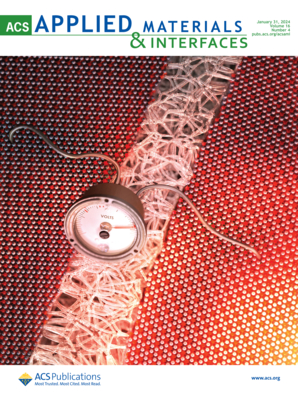A Tough Temperature-Responsive Composite for Switchable Microwave Absorption
IF 8.3
2区 材料科学
Q1 MATERIALS SCIENCE, MULTIDISCIPLINARY
引用次数: 0
Abstract
Smart microwave absorption (MA) materials that respond to environmental stimuli are highly sought after for advanced electromagnetic interference protection, particularly those with superior mechanical properties. In this study, we present a temperature-responsive composite material composed of poly(N-isopropylacrylamide) (PNIPAAm) and a polyurethane (PU) sponge loaded with graphene oxide (PU@GO), referred to as PGPC. This composite exhibits switchable MA behavior below and above its lower critical solution temperature (LCST). Below LCST at 20 °C, the material shows minimal MA effectiveness (reflection loss < −10 dB), while at 50 °C, the reflection loss significantly improves to −42 dB with a bandwidth of 3.45 GHz. Structural characterization, both in situ and ex situ, reveals that this tunable behavior is driven by the reversible dissociation and reconstruction of a three-dimensional (3D) graphene network, triggered by the thermally induced movement of PNIPAAm molecular chains grafted onto the graphene sheets. Furthermore, the incorporation of PU enhances the composite’s mechanical properties. The ability of PGPC to combine switchable MA performance with mechanical robustness makes it a promising candidate for intelligent, adaptive electromagnetic interference protection material, addressing current technological needs in dynamic environments.

一种可切换微波吸收的高温响应复合材料
智能微波吸收(MA)材料响应环境刺激是高度追求先进的电磁干扰保护,特别是那些具有优越的机械性能。在这项研究中,我们提出了一种温度响应复合材料,由聚n -异丙基丙烯酰胺(PNIPAAm)和负载氧化石墨烯(PU@GO)的聚氨酯(PU)海绵组成,称为PGPC。该复合材料在其较低临界溶液温度(LCST)以下和以上均表现出可切换的MA行为。在20°C的最低温度下,材料显示最小的毫安效率(反射损失<;−10 dB),而在50°C时,反射损耗显著提高到−42 dB,带宽为3.45 GHz。原位和非原位的结构表征表明,这种可调行为是由接枝到石墨烯片上的PNIPAAm分子链的热诱导运动引发的三维(3D)石墨烯网络的可逆解离和重建驱动的。此外,聚氨酯的加入提高了复合材料的力学性能。PGPC将可切换的MA性能与机械鲁棒性相结合的能力使其成为智能,自适应电磁干扰保护材料的有希望的候选者,解决了当前动态环境中的技术需求。
本文章由计算机程序翻译,如有差异,请以英文原文为准。
求助全文
约1分钟内获得全文
求助全文
来源期刊

ACS Applied Materials & Interfaces
工程技术-材料科学:综合
CiteScore
16.00
自引率
6.30%
发文量
4978
审稿时长
1.8 months
期刊介绍:
ACS Applied Materials & Interfaces is a leading interdisciplinary journal that brings together chemists, engineers, physicists, and biologists to explore the development and utilization of newly-discovered materials and interfacial processes for specific applications. Our journal has experienced remarkable growth since its establishment in 2009, both in terms of the number of articles published and the impact of the research showcased. We are proud to foster a truly global community, with the majority of published articles originating from outside the United States, reflecting the rapid growth of applied research worldwide.
 求助内容:
求助内容: 应助结果提醒方式:
应助结果提醒方式:


